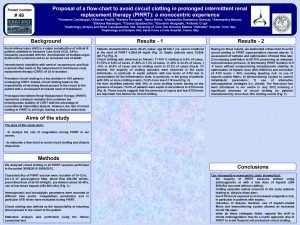Proposal of a flowchart to avoid circuit clotting

- Slides: 1

Proposal of a flow-chart to avoid circuit clotting in prolonged intermittent renal replacement therapy (PIRRT): a monocentric experience Poster number # 49 1 Vincenzo Cantaluppi, 2 Alfonso Pacitti, 1 Martina Ferraresi, 1 Ilenia Merlo, 1 Alessandro Domenico Quercia, 1 Alessandra Beccio, 1 Simona Marangon, 1 Tiziana Spadaccino, 1 Giovanni Abagnale, 1 Antonio Crupi 1 Nephrology, Dialysis and Renal Transplantation Unit, University of Turin, San Giovanni Battista “Molinette” Hospital, Turin, Italy 2 Nephrology and Dialysis Unit, Santa Croce e Carle Hospital, Cuneo, Italy Background Acute kidney injury (AKI) is a major complication of critical ill patients admitted to Intensive Care Units (ICU). AKI is frequently associated with the development of multiple-organ dysfunction syndrome and to an increased risk of death. Hemodynamic instability with need of vasopressors and fluid overload often leads to the requirement of continuous renal replacement therapy (CRRT) of 24 hr duration. Premature circuit clotting is a key problem in AKI patients undergoing CRRT. Indeed, circuit clotting leads to the impossibility of returning blood present in the circuit to the patient with a consequent increased need of transfusion. Prolonged Intermittent Renal Replacement Therapy (PIRRT) represents a dialysis modality that combines the hemodynamic stability of CRRT with the advantage of conventional intermittent dialysis. However, the rate of circuit clotting in PIRRT is still high, leading to dialysis down-time. Results - 1 Patients characteristics were: 68. 4% males; age 66. 5± 6. 1 yrs; serum creatinine at the start of PIRRT 4. 28± 0. 84 mg/dl (Fig. 2). Septic patients were 72/256 (28. 1%) (Fig. 3). Circuit clotting was observed as follows: 71 -100 % clotting in 6. 5% of cases, 51 -70% in 5. 8% of cases, 31 -50% in 7. 3% of cases, 11 -30% in 23. 4% of cases, 1 -10% in 29. 8% of cases and no clotting event in 27. 2% of cases (Fig. 4). Of interest, the majority of clotting episodes were observed in the same individuals, in particular in septic patients with low levels of ATIII due to consumption for the inflammatory state. In particular, in the group of patients with 30% or more clotting events, 74. 5% have low AT III level (Fig. 5). We then stratified patients with 30% or more clotting events basing on the presence of sepsis: 74. 5% of patients were septic in accordance to ATIII levels (Fig. 6). These results suggest that the presence of sepsis and low ATIII levels are important risk factors for circuit clotting. Results - 2 Basing on these results, we elaborated a flow-chart to avoid circuit clotting in PIRRT (representative scheme above): 1) assessment of catheter and optimization of blood flow rate; 2) increasing predilution to 60 -70% preserving an adequate transmembrane pressure; 3) decreasing PIRRT duration to 6 -8 hours without compromising hemodynamic stability; 4) optimization of heparin dose (500 -1000 U/hr) and correction of ATIII levels > 80% avoiding bleeding risk; 5) use of heparin-coated filters; 6) telemonitoring system to control intradialytic parameters; 7) use of alternative anticoagulation strategies (i. e. citrate). The flow-chart has been introduced in our centre in July 2012 inducing a significant decrease of circuit clotting (in patients characterized by more than 30% clotting events (Fig. 7). Aims of the study The aims of this study were: - to analyze the rate of coagulation during PIRRT in our centre; - to elaborate a flow-chart to avoid circuit clotting and dialysis down-time. Methods We analyzed circuit clotting in all PIRRT sessions performed in the period 30/06/2010 -30/06/2012. Conclusions Characteristics of PIRRT session were: duration of 10 -12 hr, 0. 6 -1. 8 m 2 polysulphone filter, blood flow 200 -250 ml/min, prescribed dose of 25 -30 ml/Kg/hr, pre-dilution about 30 -40%, use of low doses heparin (250 -500 U/hr) (Fig. 1). Our retrospective monocentric study showed that: - the majority of PIRRT sessions without using anticoagulants or with a low dose of heparin (250500 U/hr) occurred without clotting; - clotting episodes mainly occurred in the same patients leading to dialysis down-time; - low ATIII levels exposed to an increased coagulative risk, in particular in patients with sepsis; - reduction of dialysis duration, use of heparin-coated filters and telemonitoring system allowed an increased circuit life-span; - when all these strategies failed, regional the shift to citrate anticoagulation may be a useful approach also in PIRRT to avoid frequent and premature circuit clotting. Hemodynamic and intradialytic parameters were recorded at different time points. Coagulations parameters and in particular ATIII levels were evaluated during PIRRT. Circuit clotting was defined as the impossibility of returning blood present in the circuit to the patient. Statistical analysis was performed using the Hemer. Lemeshow test.

